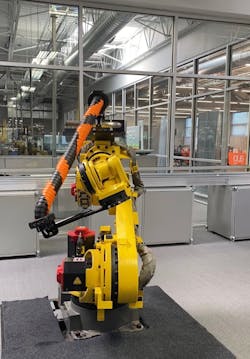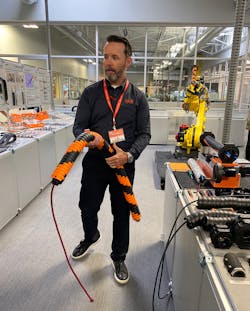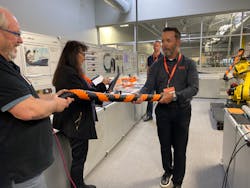Q&A with the Robot Guy: David Sandiland Discusses Robotics Cable Management
As a high-performance plastics manufacturer, igus is known for its plastic plain bearings, flexible cables and connectors, as well as its cable management products and robotic components.
Five years ago, as involvement in the robotic industry grew, the company decided to create a product and sales role that focused on cable management for robotics. David Sandiland was fortunate enough to be awarded the role, and has since traveled across North America—Mexico, the United States and Canada alike—to work with large automotive manufacturers, mom-and-pop robotics integrators and everything in between to help clients better understand the benefits and pitfalls of robotic cable management.
“There’s a lot of different ways to manage cables on robots,” Sandiland said. “I’ve seen anything from duct tape to zip ties to corrugated hose to our product. Some of them are better than others.”
Customers are generally interested in learning how to improve their existing processes. That interest, according to Sandiland, stems from both the MRO end, “where robots that have gone out into the world from an integrator or an OEM and just aren’t functioning properly because of a lack of cable management or poor cable management,” as well as from the OEMs and integrators, “who are trying to do it right the first time, rather than cobble something together and send it out into the world and hope everything works.”
Sandiland said that igus brings about 100 products to market every year. The implication is that he will routinely need to educate clients about new technologies, as well as broach topics such as cable management mistakes and retraction best practices.
Machine Design: What role does cable management play in the design and reliability of a robot?
David Sandiland: Robots can do a lot of things, but at the end of the day, they are of no use to anyone without a tool at the end of it—be that a gripper or a welding gun…All of those tools need some form of cables and hoses to go from Point A to Point B to get power for that tool. That robot is useless with that tool. That tool can work properly only if the cables are functioning properly, and that’s why the cable management portion is so important to cycle time or uptime. Downtime is a killer, especially in the larger industries like automotive. Every minute that they are down they’re losing productivity and money. Spending that money upfront for a good cable management system makes all the difference in the end.
MD: Bring us into the design space. Can you walk us through some of the relevant cable system types and how one can make specific choices, such as the right material for the application, and how this can be designed into a selection process?
DS: The cable management, as part of an overall solution, is oftentimes overlooked or left till the end. And so, we’re really encouraging designers to include it in their upfront design because it makes a big difference when they can understand the limitations of a cable product. I always tell designers that they have to understand the limitations before you’re trying to make [the application] do something that it can’t. We’re working with engineers and coming up with products that engineers tell us they want. We have a robot configurator, where the engineer can find the products based on what robot they have, and get a real sense of what it’s going to cost and look like before they get too deep into this.
The robot cable that we manufacture is a circular cable carrier called triflex R. It is a three-dimensional cable carrier. It’s different from everything else in the market. The standard in the market right now is what’s called a corrugated hose. It’s just a solid tube, where the cables go into it. The tube has no real three-dimensionality to it, so it resists torsion and resists bending. It doesn’t like moving with the robot. Whereas, the product that we offer…it does torsion with the robot; it does bend and twist and turn with the robot; it has a lot of freedom to it. So, it relieves a lot of stress on robots.
Getting into the cable portion, robots are significantly different than standard applications. In standard applications, typically, the cables are moving in one direction—whether it be vertical or horizontal. Those are called high flex, or continuous flex cables, and their construction is significantly different from a robot or torsion-running cable.
It’s really important for designers to understand the difference, because adding a continuous flex or high flex cable into a robot dress pack, regardless of the key management you choose, can really lead to some issues. We’ve seen this particularly with cables that are communication cables, sensor cables, bus cables…anything with fine copper and braided shields.
Having the proper torsion is important, but also having a product that will relieve as much mechanical stress as humanly possible on the cable from the robot motion is important. triflex R has that built into it, with the bend radius and the torsion ability of it. And that really makes a big difference when it comes to cable life versus, say, zip ties and corrugated tube.
READ MORE: Going Mainstream: Additive Manufacturing Bolsters Production Methods
MD: Tell us a bit more about the product’s stress release function. Describe the difference between the snap/lock mechanism versus a closed tube design. Why would you select one or the other in a particular application?
DS: [We have a product] called TRE. There’s a slit on each side, and it is available in nine sizes. Different applications call for different sizes, different robots, different cable packages. The benefit of this product is the fact that you have an opening on each side, and you can add and remove cables easily.
Additionally, it doesn’t matter what the size of your connector is. In many applications, the connectors are very large on the end of these cables, and if you have just a corrugated tube, you’re trying to fish that through the tube. It’s very difficult to do, if not impossible. And what ends up happening a lot of times is customers cut the connector off to feed the cable through and reattach the connector. This can lead to a host of other issues. Field wiring a lot of times will end up with premature failures. Probably 80% of our businesses comes from this application because of the ease of installation.
But to your point, there are applications where there’s going to be some particulate in the air, and they don’t really want to have the opening. We have another product called TRCF cable, which is fully closed. It is designed with openable wings for the flatheaded screwdriver, and there are three internal sections. You can open the wings, and open up a bunch of sections and layer cables in before closing it.
The other place that we use this product a lot is in laser welding. We’re seeing this applied more and more in the automotive industry. In the past welding had been a very messy, dirty application with spot welding, or MIG/TIG or wire welding. Laser welding is a new application where they use fiber optics, and they send energy to a tool and the tool laser welds.
The problem with that fiber optic cable is a very, very large bend radius. And we’ve seen a lot of customers with failures. A lot of large automotive and aerospace companies are investing a lot of money in laser welding because it’s a more efficient welding option. But it’s a very difficult cable management option. igus is the only company that has an integrated bend radius solution for laser welding. We have two sizes for that.
The closed version is probably going to be used in 20% of the time, depending on the application. We default to the open style because it gives the customer a lot more flexibility for removing cables and repairs.
MD: Take us to your robotics customer. What are some of the typical cable management mistakes that you see, or that the industry encounters?
DS: The No. 1 thing that we see is no retraction. Retraction is built-in slack. Basically, a robot does a lot of different motions, and a lot of times customers will find a reason to not implement retraction. What they end up doing is leave a loop of their cable management from the top of the arm to the end of the arm. And, yes, this will give you enough slack to make those movements. But the problems become major when that slack catches on a tool or catches on a fixture or the arm or anything like that.
Our retraction system guides give you slack on demand rather than pre-building it, and guessing and saying, “Oh, we should have six feet of length, or whatever, hanging there.” This retraction system will give you that slack, but at the same time we get the slack out of the way. So, you’re getting the required amount of conduit that you need, but not doing it artificially by adding slack to it.
We do a lot of retrofitting in MRO applications where they receive something from an OEM integrator, and the integrator did not implement retraction. The rule of thumb that we use at igus is that if you’ve got more than 180 deg. of rotation at the end of arm, between the three joints—the end of arm joints four, five and six—you really need to have retraction because there’s just no way to reliably manage that type of rotation with slack.
This system is going to give you predictability. A system that just implements slack is going to give you unpredictable things and a lot of damage. And then, on top of that you get a lot of momentum, a lot of swing.
Another big one that we see is poor bracket location at the end of arm. In a typical industrial six-axis robot, the customer will install the bracket in a perpendicular position to the bracket space. We would prefer for it to be in the same plane, pointing down, just like the robot is. This is a major issue for a lot of different reasons. One of the first things that we do when we see customers is talk about proper end-of-arm bracket location. This is the business end where all the action happens, and if you don’t have this in the right location, you’re never going to be successful.
READ MORE: Universal Robots’ Latest Cobot is Redesigned for Palletizing
MD: David, what’s new on the market?
DS: We’ve just released a new product called triflex R TRX. Our engineers put their heads together and said, “Why can’t we put the retraction right in the conduit, rather than having it separate? So now we have a product that works not too dissimilar from our triflex R TRE. The only difference is, there’s a band down the center that is going to create some form of resistance. So, it will stretch apart and retract with its own retraction system.
We just showed it at IMTS in Chicago, and the feedback from it was great. At this point, it is going to be based on material handling applications, medium- to large-size robots—the ones that don’t have the payload capacity to implement a larger retraction system, or for a customer who wants to save a little bit of money but doesn’t want to have a loop. The TRX is revolutionary and we feel really excited about it. I think the market is going to gravitate towards the simplicity.
We are in the very final stages now and I expect to have pricing available for customers by the end of October, and hopefully shipping by the end of the year.
About the Author

Rehana Begg
Editor-in-Chief, Machine Design
As Machine Design’s content lead, Rehana Begg is tasked with elevating the voice of the design and multi-disciplinary engineer in the face of digital transformation and engineering innovation. Begg has more than 24 years of editorial experience and has spent the past decade in the trenches of industrial manufacturing, focusing on new technologies, manufacturing innovation and business. Her B2B career has taken her from corporate boardrooms to plant floors and underground mining stopes, covering everything from automation & IIoT, robotics, mechanical design and additive manufacturing to plant operations, maintenance, reliability and continuous improvement. Begg holds an MBA, a Master of Journalism degree, and a BA (Hons.) in Political Science. She is committed to lifelong learning and feeds her passion for innovation in publishing, transparent science and clear communication by attending relevant conferences and seminars/workshops.
Follow Rehana Begg via the following social media handles:
X: @rehanabegg
LinkedIn: @rehanabegg and @MachineDesign



